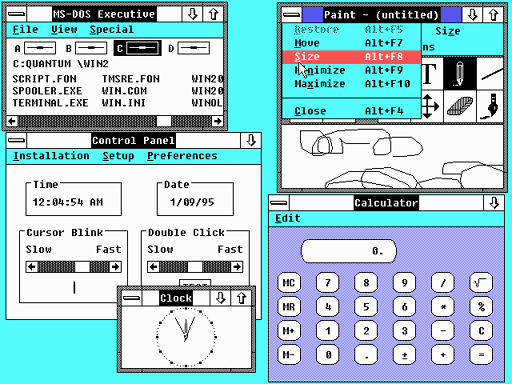I remember hearing years ago that in some kind of deal, Apple gave Microsoft permission to copy the Mac OS. Is that true? And is that how Microsoft can legally get away with it? Copying that is.
Yes, it is true. However, Microsoft was only given permission to copy Mac OS in Windows 1, but not in future versions. When this issue was brought to court, judgement was ruled in favor of Microsoft, because of breaches in the contract with Apple that Microsoft drew up.
Windows 1.0 Fails to Open MarketMeanwhile, the first version of Windows failed to catch on. The only major application written for Windows 1.01 (the first version available to the public) was Aldus PageMaker. PageMaker was actually bundled with a runtime version of Windows, since almost no PC user owned Windows.
That began to change with the release of Windows 2.0 on November, 1 1987.
 Windows 2.0 with overlapping windows (reduced from 640 x 480)
Windows 2.0 with overlapping windows (reduced from 640 x 480)Windows 2.0 was a huge improvement over version 1.0, and Sculley recognized it. The new version offered overlapping windows, multitasking, and a limited object oriented environment (through a rudimentary version of OLE).
Besides the new features, Windows 2.0 actually had programs for it. During the press conference, Microsoft revealed that it had finished developing Microsoft Word for Windows and Microsoft Excel for Windows, and that outside companies including Aldus, Corel, and Microtek were all working on Windows 2.0-compatible programs.
Sculley was shocked at how much Windows 2.0 resembled the Macintosh, and he believed this to be a breach of contract. Sculley, along with most of the Apple legal team, believed that the November 1985 agreement gave Microsoft permission to use Macintosh displays in Windows 1.x, but not in any later versions.
Talk to the JudgeWithout warning, Apple filed suit against Microsoft in federal court on March 17, 1988 for violating Apple's copyrights on the "visual displays" of the Macintosh. (Apple also filed suit against HP for its NewWave environment that ran on top of Windows 2.0.)
Apple's suit included 189 contested visual displays that Apple believed violated its copyright.
Microsoft countersued, but it failed to stem the bad publicity. Windows' development community was terrified that any court ordered changes to the software would render their products incompatible and make Windows undesirable to consumers. Borland's CEO said it was like "waking up and finding out that your partner might have AIDS."
Fortunately for Windows developers, Judge W. Schwarzer ruled on July 25, 1989, that 179 of the 189 disputed displays were covered by the existing license, and most of the other ten were not violations of Apple's copyright due to the merger doctrine (the merger doctrine stipulates that ideas cannot be copyrighted). In the case of Apple vs. Microsoft, many of the displays Apple contested were ideas and could not be protected by copyright.
The lawsuit was decided in Microsoft's favor on August 24, 1993.